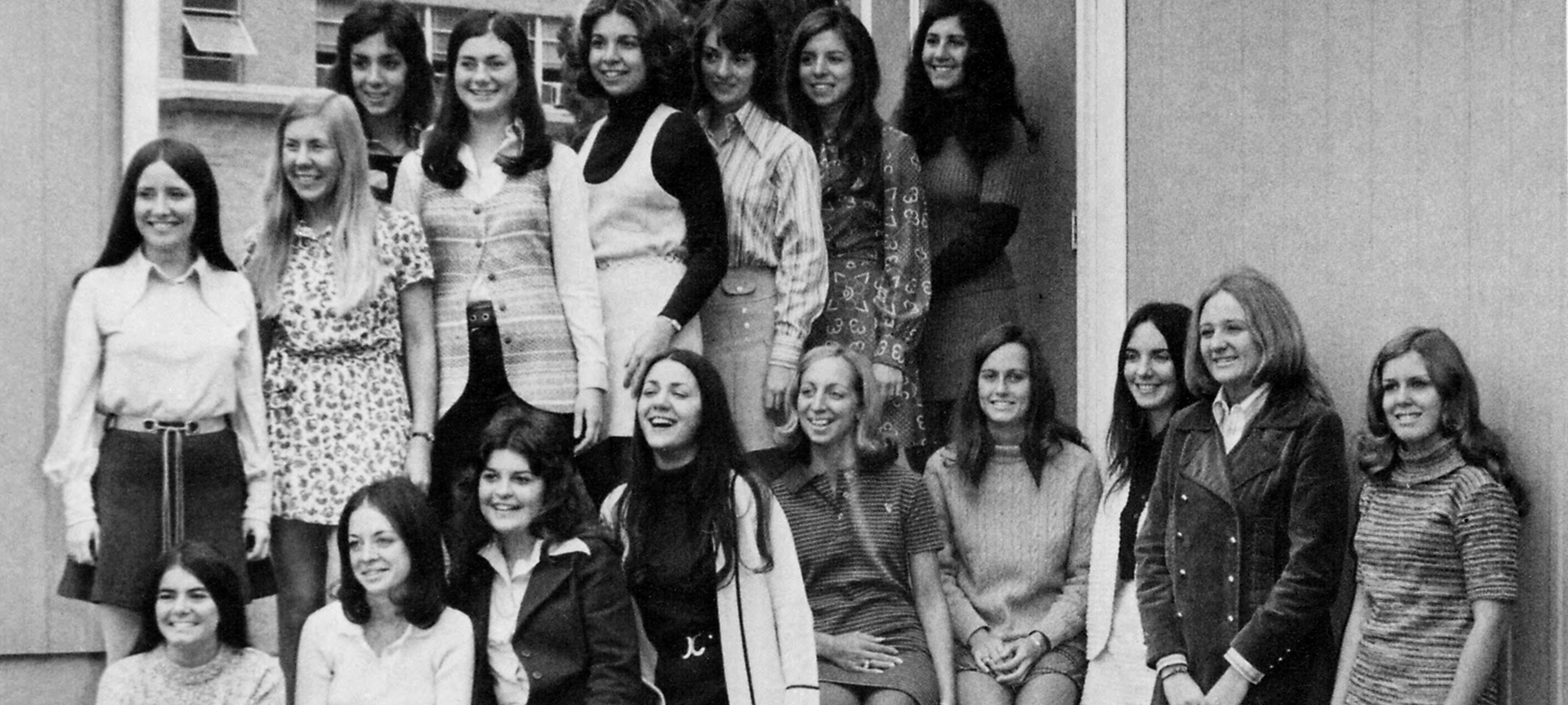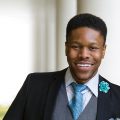They arrived nearly 50 years ago, the first full class of women on the South Orange campus, dressed as if for church. They came garbed in demure wool skirts and sweaters – never, not even through that first cold winter, in slacks. Some even tottered between classes in heels.
There was no dedicated dorm for them on campus yet, so many of them commuted by car or bus or train. Some rented houses and listened politely when their old Polish and Italian landladies clucked about the too-long hair of the men who called on them for dates.
They seemed at times like a new species migrating into an ecosystem that was still figuring out how to host them. Some of the men’s bathrooms on campus had undergone a rudimentary gender change by way of little more than a new sign on the door. The urinals were still inside.
“You were certainly looked at,” says Anita Campisi Whitehead ’72, a veteran of that Boland Hall gauntlet. “But everybody was always very equally treated, I thought. I didn’t notice any kind of talking down to us.”
“It wasn’t like a girl coming on the football team,” says Diane Garbini ’72. “I never got the feeling that you weren’t welcome, or that this was an all-guys’ school and that you shouldn’t be here.”
“They weren’t holding open the doors to let us in,” says Jacquie Salvatore ’72. “There wasn’t this big hoopla, either. If you think about it, today there probably would have been balloons and a big parade, but it wasn’t like that.”
“The student center was a much happier place with our presence, according to the guys,” says Gale Yaeger Hay ’72.
“I didn’t feel like they resented us being there at all,” says Karen Cubero ’72.
And the women had to do some learning, too — about fraternity mixers, basketball games and the geography of their new home. On Cubero’s first evening on campus, on a summer visit to look for a place to live, she shared a table in the dining hall with a male student, a junior taking summer classes. “He said, ‘Do you want to go to the village?’ and I said, ‘The village?’ I thought he meant Greenwich Village.”
He didn’t. They strolled down into the Village of South Orange for ice cream at Gruning’s.
At a university named for a woman, women have never been strangers. Women religious from the the order founded by Saint Elizabeth Ann Seton, the Sisters of Charity, served at the school as nurses, cooks and domestic workers from its earliest years. The first female students enrolled in the 1930s, at what were known as the Extension Divisions — small satellite campuses in Newark, and Jersey City, where women outnumbered men, and where the total enrollment outnumbered the enrollment at the main campus in South Orange.
Of the 19 bachelor’s degrees awarded at the Extension Division’s first graduation in 1937, 11 went to women religious, and four to lay women.
Women taught on the faculty, and the first dean of the law school was a woman, Miriam Rooney, in 1951. Women religious came to South Orange for summer classes, and nursing students from Newark came to use the chemistry labs on Saturday mornings, but it wasn’t until the early 1960s that the discussion turned to opening the final door — full coeducation on the main campus.
“By broadening the base of applicants to include women, Seton Hall can find quality in quantity,” a student wrote in The Setonian in 1963. “A higher caliber woman would replace a lower caliber man, and their loss is the University’s gain.”
Another student put it more plainly in The Setonian that year: “These men who are yelling ‘bring on the girls’ are the same ones who will be yielding their seats to a more intelligent and mature female.”
Support for coeducation was building within the administration and faculty then, too. “Though the education of males alone has a particular value and in certain circumstances is the best policy, it seems to me that in our own circumstances now that times have so radically changed, that coeds ought to be invited to the campus day program as a means of bettering our total academic environment,” the dean of the college, Albert Hakim, wrote in 1963. “After all, women aren’t freaks.”
But there was one last obstacle. “Women were not allowed on campus for one reason — that the divinity students were present on the campus,” Hakim says now. “In the minds of some ecclesiastically minded persons, that was an important consideration.”
After the divinity students were moved to the seminary at Darlington, Hakim says, “the road to accepting women on campus became a little easier for some.”
The pioneers were a tiny group of women, maybe a dozen in each year, in two honors programs: one in chemistry and one in humanities. “We were sort of oddities, but really only once or twice did I feel in classrooms as if I was the odd person out,” says Beatrice Granville Jacobson ’67, a retired English professor at Saint Ambrose University in Iowa, where her husband, Paul ’67, retired as a philosophy professor and dean. They met in a philosophy class junior year. “Generally speaking, the faculty were receptive.
“Any faculty who saw a woman in one of their daytime classes knew this was an honors student so they knew we were serious, so that probably helped.”
She commuted from her parents’ home in Mendham, never in slacks, which were prohibited on women by school policy. “It just wasn’t done at the time by anybody,” she says. “I also think there was a way in which, in subtle ways at least, we were trying not to draw any more attention to ourselves.”
The next step came at the start of the spring semester in 1968, when 640 women started taking classes in South Orange after the Newark satellite campus closed. “It was an earthquake on campus because for the first time you had more than those few humanities honors women moving across campus,” says Bob Windrem ’68, who was then editor of The Setonian, which argued in favor of coeducation. “As I can recall, the first mixing of the sexes was sort of tentative because nobody knew what to expect.”
Windrem himself offered some private advice to university president Bishop John Dougherty in a conversation before women arrived on campus. “I pointed out to him that perhaps he might want to take a look at the carvings and the graffiti on the various desks throughout the university because, as one might expect at an all-male school, there were a lot of, shall we say, inappropriate comments,” Windrem says. “I have no idea if this was as the result of anything I said, but I can remember coming back for the new semester and seeing that all the desks had been sanded and painted black.”
The final step was the arrival in South Orange of the entering class of freshmen in the fall of 1968, not all of whom knew they were upending a century-old tradition. “The first I knew that The Hall had been all male was at an orientation session the day before classes began,” says Anita Whitehead, who was in the humanities honors program, as was her husband, Jim ’70. “A guy in my group complained that he had not been told there would be women on campus, leaped up and ran out.”
Most of the first women majored in either elementary education or nursing, so in many of their classes they were surrounded by other women. But in some of the large introductory lecture classes, and in classes outside their majors, they were often surrounded by men. Anita Whitehead’s Russian professor opened each class with a greeting he had never used before. “He would always say, ‘Good morning, gentlemen,’ and then he would turn to me and add, ‘and lady,’” she says. “It was not sarcastic. It was truly, ‘Oh, I forgot you.’ He was just so used to saying, ‘Good morning, gentlemen,’ and then I showed up.”
Women were also outnumbered in the student center, where the fraternity brothers commandeered long tables at which they hung their Greek banners and congregated between classes. “I can envision walking into the bottom of the student center and all the Greek tables were down there then and just seeing this massive amount of guys,” says Diane Garbini, an elementary education major who had gone to an all-girls high school, East Orange Catholic, and who commuted from her home in Livingston. “You just walked in and there was this sea of men and I was kind of like, ‘OK, where am I?’”
The women soon countered by commandeering some tables of their own for the sororities they formed. “It was kind of crazy when you think about it, because there was no sorority house, just a table,” says Jacquie Salvatore, who went to East Orange Catholic with Garbini and wore the same blue beanie with gold letters when they both pledged to Sigma Theta Sigma.
She commuted from her home in Newark. “You sat at your little table at lunch, and you hung out at that table.”
A residence hall for women didn’t open until that first coed class reached its senior year, so most women commuted, including a transfer sociology major from Fordham University who lived with her parents in Orange and worked in the payroll department at Sears in the Livingston Mall: Mary Meehan ’72/M.A. ’74/Ph.D. ’01, the University’s current interim president.
Women who didn’t commute lived in off-campus houses, like the room with a bed and a fold-out couch in Mrs. Jazcinski’s house on Norman Road that Gale Hay and her roommate shared as freshmen. “If we pulled that couch out for a bed there was no room to do anything else. We brought our parents in and they were speechless,” Hay says.
As sophomores, they moved into a sprawling three-story house on Montrose Street where they had a kitchen, a balcony and enough bedrooms for seven of their friends to eventually join them. “The bathroom there was as big as the whole room we lived in as freshmen.”
And by the time they moved into the bigger house with the bigger bathroom, they, and all of their classmates, were no longer required to wear skirts or dresses on campus. “I remember as dean one of the student advisers called me and asked if I had any objection to doing away with that requirement for the women as long as they were modestly dressed,” Albert Hakim says. “I said I had no objection at all.”
Jeans soon proliferated, as they did on denim-clad campuses across the country. “So we went from this place that did not allow women to wear pants on campus to being in Life magazine for being Vietnam protesters,” Hay says. “It was a fast-changing time.”
All those women in pants were so quickly absorbed into campus life that it soon became hard to imagine a time without them. Women now make up 55 percent of the university’s undergraduate population.
Coeducation had some other lasting effects, too. When Karen Cubero returned to South Orange after her summer visit to start her freshman year, she moved into an attic bedroom off campus with another nursing student and a chemistry major. “We were just so happy to be on our own we didn’t care,” she says.
She also started dating John Cubero ’71, the junior biology major — and future cardiologist — who had invited her to the village for ice cream. They have been married for 44 years.
Written by Kevin Coyne








Thank you for this story. A wonderful memory. So proud to be part of this SHU history .
Jill Lenk Schilp
Texas
College of Nursing 1968